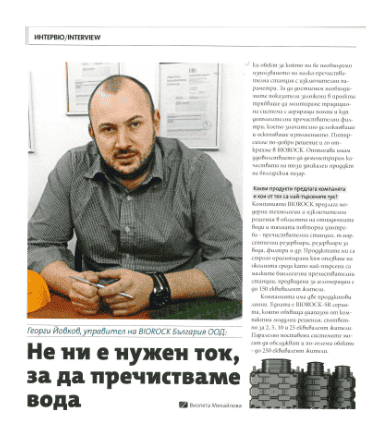 Georgi Iovkov Manager; BIOROCK Bulgaria Ltd.
Georgi Iovkov Manager; BIOROCK Bulgaria Ltd.Interview by Violeta Mihaylova
Dear Mr. Yovkov, when BIOROCK was established and what was the activity of the company?
BIOROCK is a leading international company with 26 years of experience in the field of wastewater. It is established in 1988 in Luxembourg and has a team of highly qualified experts considered one of the best in the industry. The mission of the company is to generate innovative approaches for the correct and successful solution of problems related to municipal and industrial wastewater treatment. The aim is to be useful and practical, providing adequate, easy and economic solutions for effective treatment of wastewater, in harmony with nature.
How did you manage to attract this international company to the Bulgarian market? Since when has it been known to the clients in the country?
The BIOROCK treatment plants are known to our market since 2011. I personally learned about the company products when working on a project requiring a small treatment plant with extraordinary parameters. In order to reach the necessary indicators set in the project we had to install a traditional system with aeration pumps and a number of additional cleaning filters which would considerably complicated and raised the cost of the execution. Therefore, we sought a better solution and found it in BIOROCK. Since then, I have the pleasure to demonstrate the qualities of this unique product at the Bulgarian market.
What products are offered by the company and which of them are in great demand here?
BIOROCK offers modern technologies and extraordinary solutions in the field of wastewater and its reuse- trentment plants, the so called septic tanks, water reservoirs, filters, etc. Our products are environmentally friendly, the small biological treatment plants for agglomerations of up to ISO people equivalent (PE) being in greatest demand. The company has two product lines. One is BIOROCK-SR series which comprises a range of modular compact solutions for 2, 5, 10 and 25 PE. Put in parallel, the systems may serve bigger projects- up to 250 PE. The second line is BIOROCK-MR series including systems for medium-size projects, between 250 and 600 people. Put in parallel, they may serve projects for 800, 1200 people, etc.
You say that the BIOROCK plants represent an extraordinary solution. What mostly distinguish them from the traditional equipment?
The lack of power. Our systems do not need electric power for operation. Their principle of operation is: complete treatment without electric power supply. Besides, the BIOROCK equipment does not contain any mechanical components. These two features only clearly determine the advantages of our revolutionary small size treatment plants which are very costeffective in operation and maintenance. The BIOROCK products use the circulation of the atmospheric air and function in harmony with nature. They are subject
to the natural physical processes and pay off in a short period of time. In the traditional systems, the wastewater treatment is realised by equipment which should be connected to an electric power source, and this could be quite costly.
Here we touch the price factor. It is not a secret that for the client the initial sum he pays is quite important. In other words, it should be as low as possible...
Yes, we all seek a reduction of the initial price. Are we thinking, however, about the subsequent costs during the operation of a given product? The traditional treatment systems are continuously consuming electric power for driving pumps, compressors or aerators. All these raise the expenses of their operation. Besides, maintenance should be made one to three times per year. This is associated with visits of experts, usc of a scraper, extraction and disposal of sludge. etc. One such visit only costs about 300 Lev. Just for comparison - the BIOROCK system needs cleaning once per three years.
How these modern systems function? Tell us in more detail.
The primary settlement tank degrades anaerobically the biomass and the produced gases arc evacuated to the atmosphere. The formed cover in the primary settlement tank prevents odour distribution. The anaerobically degraded and settled water passes through a filter loaded with a specially treated pack of enzymes for fast aerobic degradation of the biomass while the atmospheric air is continuously passing through the pack, realising a natural circulation. As a result from the filtration and anaerobic biodegradation, the treated water has very low pollution indicators: BOD >99% 4 mg/1; COD 96% 26 mg/l; suspended solids 99% 3 mg/l at 0 kWh electric power. It can be directly discharged into sensitive receiving water, while this is not admissible for the standard systems. But we offer solutions for this case too. The traditional equipment can be modernised through an additional biological reactor offered by BIOROCK.
Are the facilities for local treatment and disposal of wastewater being good alternative to the central sewer system?
Of course. This is the future. If we want to follow Europe or even South Africa we have to take advantage of the foreign experience. In these countries people prefer the small treatment plants instead of the large ones which require expensive and frequent maintenance procedures on the account of all citizens in the region. The small treatment systems will make people feel more responsible for the environmental protection, and the water utilities will have at their disposal more time and investments for water supply, thus reducing water loss as well. One key point here, however, is exercising quality control over the effluents. In my opinion, this control may be entrusted to the water utilities. Only they have enough human resources to cope with these activities.